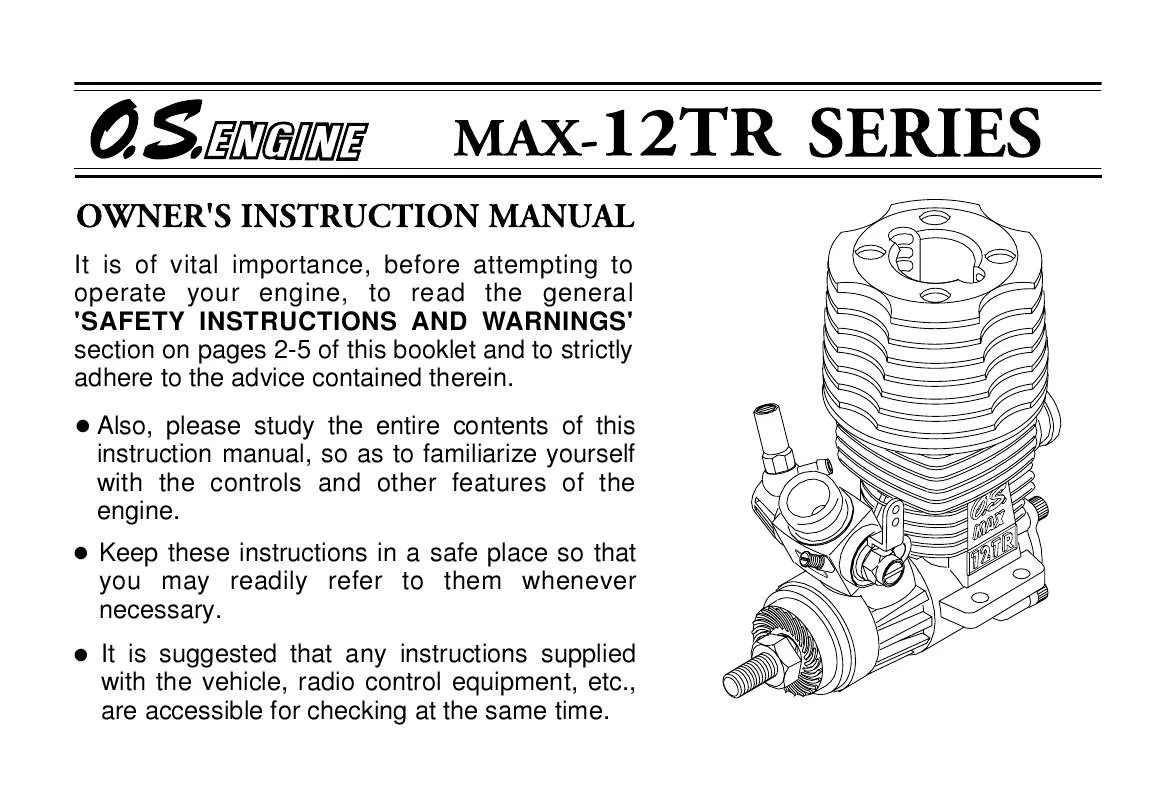Detailed instructions for use are in the User's Guide.
[. . . ] It is of vital importance, before attempting to operate your engine, to read the general 'SAFETY INSTRUCTIONS AND WARNINGS' section on pages 2-5 of this booklet and to strictly adhere to the advice contained therein.
q
Also, please study the entire contents of this instruction manual, so as to familiarize yourself with the controls and other features of the engine. Keep these instructions in a safe place so that you may readily refer to them whenever necessary. It is suggested that any instructions supplied with the vehicle, radio control equipment, etc. , are accessible for checking at the same time.
q
q
CONTENTS
SAFETY INSTRUCTIONS AND WARNINGS ABOUT YOUR O. S. ENGINE INTRODUCTION, BASIC ENGINE PARTS INSTALLATION AIR CLEANER TYPE 103 GLOWPLUG TOOLS, ACCESSORIES, etc. [. . . ] When the battery is disconnected, the heat retained within the combustion chamber remains sufficient to keep the plug filament glowing, thereby continuing to keep the engine running. Ignition timing is 'automatic' : under reduced load, allowing higher rpm, the plug becomes hotter and, appropriately, fires the fuel/air charge earlier; conversely, at reduced rpm, the plug become cooler and ignition is retarded.
of nitromethane unless more is essential for racing events.
· Do not run the engine too lean and do not leave the
When to replace the glowplug
Apart from when actually burned out, a plug may need to be replaced because it no longer delivers its best performance, such as when:
· Filament surface has roughened and turned white. · Filament coil has become distorted. · Foreign matter has adhered to filament or plug
body has corroded.
· Engine tends to cut out when idling. · Starting qualities deteriorate.
9
TOOLS, ACCESSORIES, etc.
The following items are necessary for operating the engine.
Reminder!
Model engine fuel is poisonous. Do not allow it to come into contact with the eyes or mouth. Always store it in a clearly marked container and out of the reach of children. Model engine fuel is also highly flammable. Keep it away from open flame, excessive heat, sources of sparks, or anything else which might ignite it.
FUEL
Use only top quality methanol-based model engine fuel. For consistent performance and long engine life, it is advisable to use fuel containing AT LEAST 18% lubricant. This engine is designed to run on both low and high nitromethane content fuels, i. e. from mild mixtures containing a few percent of nitromethane, up to highspeed racing fuels containing 40%, nitromethane. Generally, power output is increased-up to a certain point-as the nitromethane content of the fuel is increased. As a starting point, we recommend a fuel containing 10-20% nitromethane, changing to a fuel containing more nitro only if necessary. When the nitro content of the fuel is increased or the brand of fuel is changed, it is advisable to initially run the engine with a richer needle-valve setting, so that the optimum setting for the new fuel may be rechecked as described in the RUNNING-IN paragraphs. When engines are run at very high speeds and on high-nitro fuels, glowplug elements do not last so long.
ELECTRIC STARTER BOX
For starting the engine.
BATTERY INTEGRATED GLOWPLUG HEATER
Commercialy available handy glowplug heater in which the glowplug battery and battery leads are integrated.
FUEL PUMP
For filling the fuel tank, a simple, polyethylene "squeeze" bottle, with a suitable spout, is required. 10
LONG SOCKET WRENCH
Recommended for easy removal and replacement of the angled and recessed glowplug, the O. S. Long Socket Wrench incorporates a special grip.
CARBURETTOR CONTROLS (10J)
Three adjustable controls are provided on this carburettor.
·
The Needle-Valve:
For adjusting the mixture strength when the throttle is fully open.
SILICONE FUEL LINE
Heatproof silicone tubing of approx. The rich mixture will, under these conditions, provide adequate lubrication and cooling, indicated by profuse smoke from the exhaust.
Needle
30°
The position of the needle-valve when starting the engine.
30 °
30°
· Next,
disconnect the glowplug battery and try running the car on the track. If the engine stalls, open the throttle fractionally, but try to keep the engine running as rich as possible: if it stops because of being excessively over-rich, close the Needle-Valve 30° and try again.
Close the needle-valve approx. 30° after running the vehicle for every five full tanks of fuel. Repeat this procedure around 5 times.
· To stop the engine, close the throttle to idling speed,
then shut it off completely with the trim lever on the transmitter. To cut off the fuel supply, pinch the fuel delivery tube to the carburettor.
· Run the car on the track until five tanks of fuel has been
consumed, then close the Needle-Valve 30°. Repeat this procedure until around 5 times of fuel have been consumed, during which time the throttle may be opened for brief bursts of increased power. [. . . ] It is also recommended that a good in-line filter be installed between the tank and carburetor. Do not forget to clean the filters regularly to remove dirt and lint that accumulate on the filter screens. Also, clean the carburetor itself occasionally. At the end of each operating session, drain out any fuel that may remain in the fuel tank. [. . . ]


